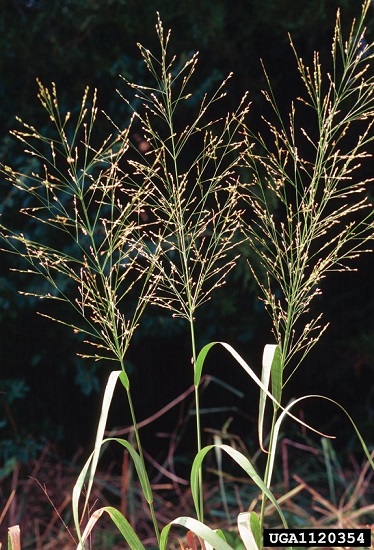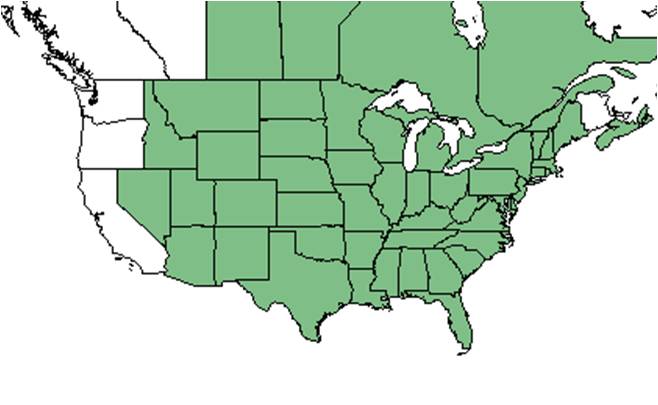Difference between revisions of "Panicum virgatum"
(→Ecology) |
|||
| Line 53: | Line 53: | ||
This species is thought to be dispersed by gravity.<ref>Kirkman, L. Katherine. Unpublished database of seed dispersal mode of plants found in Coastal Plain longleaf pine-grasslands of the Jones Ecological Research Center, Georgia.</ref> | This species is thought to be dispersed by gravity.<ref>Kirkman, L. Katherine. Unpublished database of seed dispersal mode of plants found in Coastal Plain longleaf pine-grasslands of the Jones Ecological Research Center, Georgia.</ref> | ||
<!--===Seed bank and germination===--> | <!--===Seed bank and germination===--> | ||
| − | + | ||
| + | ===Fire ecology=== <!--Fire tolerance, fire dependence, adaptive fire responses--> | ||
| + | Populations of ''Panicum virgatum'' have been known to persist through repeated annual burning.<ref>Platt, W.J., R. Carter, G. Nelson, W. Baker, S. Hermann, J. Kane, L. Anderson, M. Smith, K. Robertson. 2021. Unpublished species list of Wade Tract old-growth longleaf pine savanna, Thomasville, Georgia.</ref> | ||
| + | |||
===Pollination and use by animals=== | ===Pollination and use by animals=== | ||
''Panicum virgatum'' has been observed to host ladybugs such as ''Coccinella novemnotata'' (family Coccinellidae).<ref>Discoverlife.org [https://www.discoverlife.org/20/q?search=Bidens+albaDiscoverlife.org|Discoverlife.org]</ref> | ''Panicum virgatum'' has been observed to host ladybugs such as ''Coccinella novemnotata'' (family Coccinellidae).<ref>Discoverlife.org [https://www.discoverlife.org/20/q?search=Bidens+albaDiscoverlife.org|Discoverlife.org]</ref> | ||
Revision as of 19:45, 26 July 2021
| Panicum virgatum | |
|---|---|

| |
| Photo by James H. Miller & Ted Bodner, Southern Weed Science Society, Bugwood.org | |
| Scientific classification | |
| Kingdom: | Plantae |
| Division: | Tracheophyta- Vascular plants |
| Class: | Lilianae - Monocotyledons |
| Order: | Poales |
| Family: | Poaceae |
| Genus: | Panicum |
| Species: | P. virgatum |
| Binomial name | |
| Panicum virgatum L. | |

| |
| Natural range of Panicum virgatum from USDA NRCS Plants Database. | |
Common names: Switchgrass[1], Blunt panic grass, Tufted switchgrass
Contents
[hide]Taxonomic notes
Synonyms: none.[1]
Varieties: Panicum virgatum Linnaeus var. cubense Grisebach; Panicum virgatum Linnaeus var. spissum Linder; Panicum virgatum Linnaeus var. virgatum.[1]
Description
"Spikelets usually in panicles, round or nearly so in cross section, 2-flowered, terminal fertile, basal sterile, neutral or staminate. First glume usually present, 2nd glume and sterile lemma similar; fertile lemma and palea indurate without hyaline margins. Taxonomically our most difficult and least understood genus of grasses, more than 100 species and varieties are ascribed to the Carolinas by some authors. Note general descriptions for species groups (e.g., 1-4, 5-8, 9-13, and 26-62)."[2]
"Elongate, rhizomatous perennial; culms 5-15 dm tall. Blades to 5 dm long, 1.5-8 mm wide, sparsely pilose above basally; sheaths occasionally pubescent, margins occasionally densely ciliate; ligules ciliate or lacerate, 1.5 mm long. Panicle open, 12-50 cm long, 6-20 cm broad. Spikelets 2.8-4.2 mm long. Frist glume 5-9 nerved, acute to keeled-cuspidate, 1.4-3.0 mm long, 2nd glume and sterile lemma 7-9 nerved, acute to cuspidate, 2.8-4.2 mm long, sterile palea2-2.6 mm long; fertile lemma 2-2.6 mm long. Grain grayish, 1-2 mm long."[2]
The spikelets of var. cubense are 2.8-3.5 mm long, and the first glume (blunt-) acute, ½-⅔× as long as the spikelet. The beak of the sterile lemma exceeds the fertile lemma by 0.2-0.5 mm. Adversely, the spikelets of the other varieties are 3.2-5 mm long, where the first glume is acuminate, ⅗-¾x as long as the spikelet. The beak of sterile lemma exceeding fertile lemma by 0.6-1.3 mm. Var. spissum can be distinguished by its short, densely-interlocking rhizomes and subascending, basal culms. It also grows densely clumped. Var. virgatum the rhizomes are elongate, the culms are horizontally divergent, and it grows loosley-clumped.[1]
Panicum virgatum does not have specialized underground storage units apart from its rhizomes.[3] Diaz-Toribio and Putz (2021) recorded this species to have an non-structural carbohydrate concentration of 192.3 mg/g (ranking 24 out of 100 species studied).[3]
Distribution
Var. cubense is found in the Coastal Plain from Massachusetts to Florida, and west to Missouri and Michigan. It also grows in the West Indies. Var. spissum grows from East Canada to Pennsylvania, Maryland, and Deleware. Var. virgatum has the broadest range, from southwest Quebec to Florida and Texas, then west to Nevada. Its range also extends to Bermuda, Central America, and South America.[1]
Ecology
Habitat
P. virgatum has been found in pine flatlands, salt marsh shorelines, woodland clearings, sandy alluviums, hammocks with brackish marsh, tidal marshes, peat of cabbage palm hammock, secondary cypress swamp, limerock banks, and loamy sand areas.[4] It is also found in disturbed areas including clear cut longleaf pine sand ridges, slash pine forest, powerline clearings, and reforested pineland.[4]
The species became absent or decreased its occurrence in response to soil disturbance by agriculture in southwest Georgia. It has shown resistance to regrowth in reestablished pinelands that were disturbed by these practices.[5][6]
The variant cubense frequents wet to dry sandy pinelands. Var. spissum grows in gravelly or sandy fresh to brackish shores and swamps. Var. virgatum is found in dry or wet sandy soils of pinelands, fresh and brackish marshes, and shores.[1] It is abundant in the Calcareous Savannas and Upper Panhandle Savannas community types as described in Carr et al. (2010).[7]
Associated species: Pinus elliottii, Sabal palmetto, Serenoa repens, Chasmanthium, Chloris, Paspalum, Pinus palustris, Quercus laevis, Quercus geminata, Quercus laurifolia, Quercus margaretta, Vaccinium arboreum, and Cyrilla recemiflora, Rhynchospora spp., Panicum spp., and Juniperus silicicola.[4]
Phenology
P. virgatum flowers from Jun through October.[1]
Seed dispersal
This species is thought to be dispersed by gravity.[8]
Fire ecology
Populations of Panicum virgatum have been known to persist through repeated annual burning.[9]
Pollination and use by animals
Panicum virgatum has been observed to host ladybugs such as Coccinella novemnotata (family Coccinellidae).[10]
Conservation, cultivation, and restoration
P. virgatum should avoid soil disturbance by agriculture to conserve its presence in pine communities.[5][6]
Cultural use
Photo Gallery
References and notes
- ↑ Jump up to: 1.0 1.1 1.2 1.3 1.4 1.5 1.6 Weakley, A.S. 2015. Flora of the southern and mid-atlantic states. Working Draft of 21 May 2015. University of North Carolina at Chapel Hill, Chapel Hill, North Carolina.
- ↑ Jump up to: 2.0 2.1 Radford, Albert E., Harry E. Ahles, and C. Ritchie Bell. Manual of the Vascular Flora of the Carolinas. 1964, 1968. The University of North Carolina Press. 145. Print.
- ↑ Jump up to: 3.0 3.1 Diaz-Toribio, M.H. and F. E. Putz 2021. Underground carbohydrate stores and storage organs in fire-maintained longleaf pine savannas in Florida, USA. American Journal of Botany 108: 432-442.
- ↑ Jump up to: 4.0 4.1 4.2 Florida State University Herbarium Database. URL: http://herbarium.bio.fsu.edu. Last accessed: June 2021. Collectors: J. Richard Abbott, Loran C. Anderson, S.T. Cooper, R.K. Godfrey, Bruce Hansen, JoAnn Hansen, R. Kral, Olga Lakela, Robert L. Lazor, D. L. Martin, Robert A. Norris, James D. Ray Jr., and Jean Wooten. States and counties: Florida: Calhoun, Citrus, Dixie, Franklin, Gadsden, Gulf, Levy, Leon, Liberty, Okaloosa, Palm Beach, and Wakulla. Virginia: Dinwiddie.
- ↑ Jump up to: 5.0 5.1 Kirkman, L.K., K.L. Coffey, R.J. Mitchell, and E.B. Moser. Ground Cover Recovery Patterns and Life-History Traits: Implications for Restoration Obstacles and Opportunities in a Species-Rich Savanna. (2004). Journal of Ecology 92(3):409-421.
- ↑ Jump up to: 6.0 6.1 Ostertag, T. E. and K. M. Robertson. 2007. A comparison of native versus old-field vegetation in upland pinelands managed with frequent fire, South Georgia, USA. Tall Timbers Fire Ecology Conference Proceedings 23: 109-120.
- Jump up ↑ Carr, S.C., K.M. Robertson, and R.K. Peet. 2010. A vegetation classification of fire-dependent pinelands of Florida. Castanea 75:153-189.
- Jump up ↑ Kirkman, L. Katherine. Unpublished database of seed dispersal mode of plants found in Coastal Plain longleaf pine-grasslands of the Jones Ecological Research Center, Georgia.
- Jump up ↑ Platt, W.J., R. Carter, G. Nelson, W. Baker, S. Hermann, J. Kane, L. Anderson, M. Smith, K. Robertson. 2021. Unpublished species list of Wade Tract old-growth longleaf pine savanna, Thomasville, Georgia.
- Jump up ↑ Discoverlife.org [1]